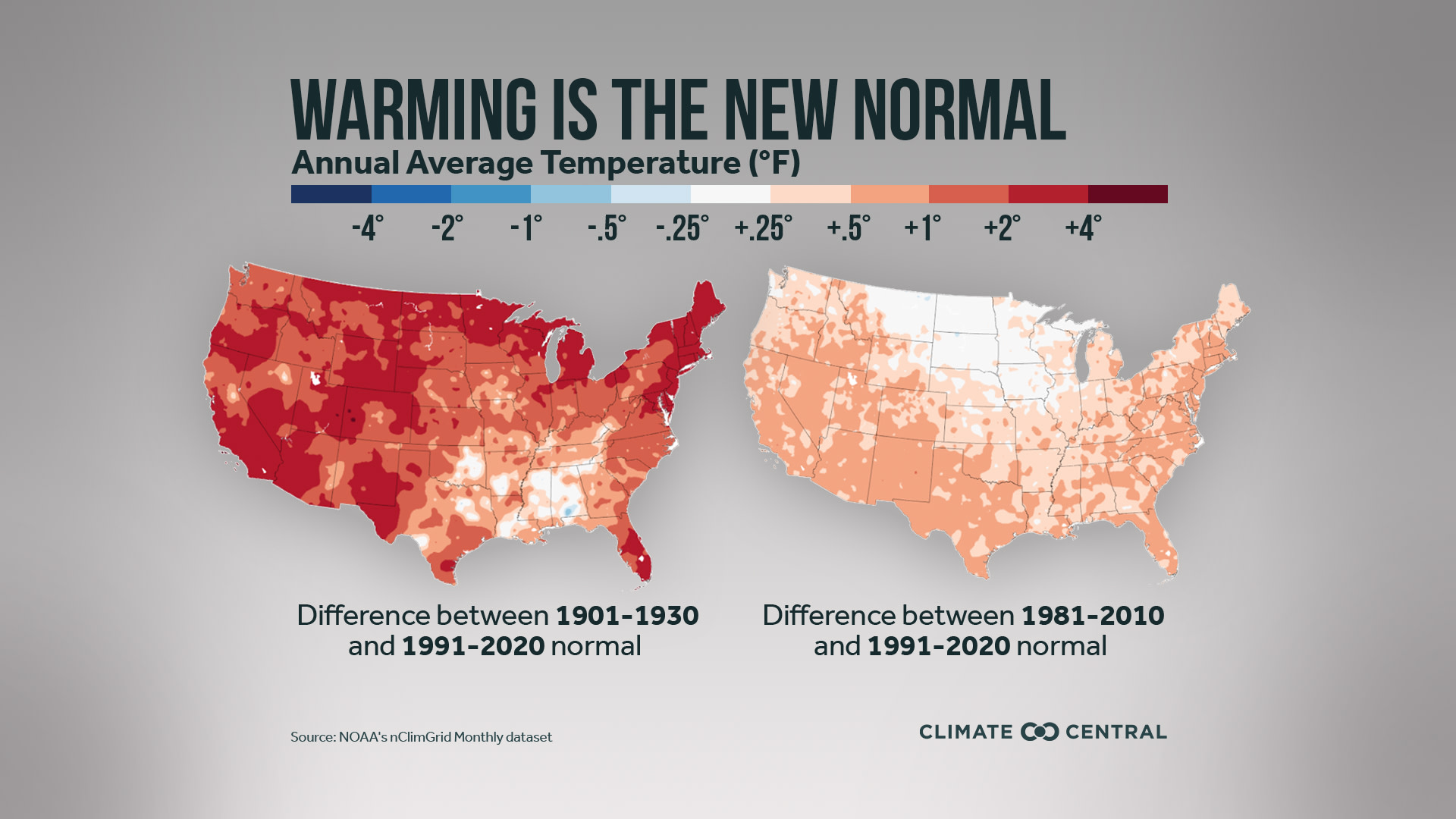KEY CONCEPTS
NOAA climate normals were updated this week. The climate normals, updated every ten years, are 30-year averages of climatological variables which give us a reference point for comparing current weather against what’s considered “normal”.
Climate normals also provide important information for a range of economic sectors, informing growers’ decisions on when to plant crops and what crops to plant, how electrical utilities can expect energy demand to vary by season, and planning construction projects.
Warming between our new normal period (1991-2020) and the previous one (1981-2010) was widespread across the U.S., with the exception of the northern Great Plains.
While warming was significant even in the past decade, zooming out to look at the steady increases in temperature with each normals update since the turn of the 20th century is striking.
U.S. NOAA Climate Normals were updated this week. The climate normals, updated by NOAA NCEI once every ten years, are 30-year averages of climatological variables (including temperature and precipitation) which give us a reference point for comparing current weather against what’s considered “normal” for a given location and its climate. They also provide important information for a range of economic sectors, informing growers’ decisions on when to plant crops and what crops to plant, how electrical utilities can expect energy demand to vary by season, and planning construction projects.
How have temperatures changed over the past decade? Warming between our new normals period (1991-2020) and the previous one (1981-2010) was widespread across the U.S., with the exception of the northern Great Plains, which cooled slightly.
What do the U.S. Climate Normals tell us about climate change? Putting the words “normal” and “climate” together can seem like a foreign concept these days, as extreme weather events become more common in our warming world. The new normals show us that, even in the past decade, warming was significant in most places. With each decadal update of the climate normals, temperatures keep creeping up. It’s even more striking when you take a look at the bigger picture, comparing the newest normals to data from the beginning of the 20th century (1901-1930). The warming pattern due to climate change is almost everywhere, with 76% (183) of the 242 cities analyzed reporting an increase of 1℉ or more.
It’s time to pause and take stock. Rather than being caught like a frog in increasingly hot water, we must focus on reducing our carbon dioxide (CO2) emissions to mitigate the rapid pace of warming illustrated by each new installment in the climate normals.
What’s to come from Climate Matters: May is typically the time of year that atmospheric carbon dioxide levels reach their annual peak. This year we’ve already exceeded 420 parts per million (ppm) of CO2—the highest level in recorded history and a 50% increase since the pre-industrial era. Keep an eye out for our upcoming coverage of the annual peak in CO2.
POTENTIAL LOCAL STORY ANGLES
What do climate normals mean to my community?
Climate Normals aren’t just used to describe weather—they’re incorporated into decision-making across a range of sectors. Consider interviewing professionals from industries that use climate normals, such as: growers, municipal officials, city planners, electrical companies, construction companies and insurance groups.
Where can I find more information on the new climate normals?
On the NCEI website, NOAA provides national maps for other temperature and precipitation metrics which you can customize by month or season. You can also create local charts, choosing your own parameter and time scale.
LOCAL EXPERTS
The SciLine service, 500 Women Scientists or the press offices of local universities may be able to connect you with local scientists who have expertise on our warming climate. The American Association of State Climatologists is a professional scientific organization composed of all 50 state climatologists. You can find local city planners by connecting with members of your state’s American Planning Association chapter. Connect with farmers and other agricultural experts through your region’s USDA Climate Hub.
NATIONAL EXPERTS
Michael A. Palecki, Ph.D., is a Physical Scientist for NOAA’s National Centers for Environmental Information in Asheville, North Carolina. He is the Project Manager for the 1991-2020 U.S. Climate Normals. He has worked on projects ranging from the validation and use of climate measurements taken in the mid-19th Century to studying today’s climate using the U.S. Climate Reference Network, a national research quality modern system to collect U.S. climate observations.
Contact: michael.palecki@noaa.gov
Victor Murphy
NWS Southern Region Climate Service Program Manager
Available for interviews in Spanish
victor.murphy@noaa.gov
METHODOLOGY
Annual normals for the contiguous United States were estimated using NOAA’s nClimGrid Monthly dataset. Anomalies are relative to the 20th century (1901-2000) average. The normal values have been estimated and may vary slightly from NOAA’s official calculations.
